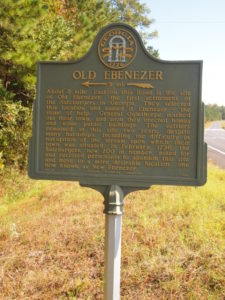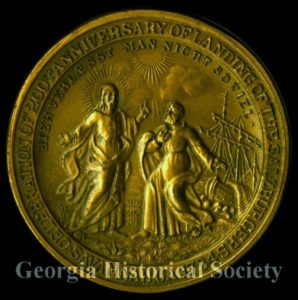In honor of the 2016-2017 Georgia History Festival, “A State of Innovation,” the February #MarkerMonday posts will focus on Savannah, the founding city of Georgia, and the many different groups of people that came to settle in Georgia. Over the course of the month, these posts will discuss four different communities that settled in Savannah and south Georgia.
 This week’s #MarkerMonday highlights the Salzburgers, a group of settlers who came to the Colony of Georgia from the independent Salzburg in Bavaria. When the Catholic Archbishop of Salzburg expelled German Protestants from the region, now present-day Austria, in 1731, King George II and the Georgia Trustees offered the Salzburgers refuge in the new colony of Georgia. Approximately 300 people accepted the invitation and followed Pastor Johann Martin Bolzius (also spelled Boltzius) to the Colony of Georgia. The first group of settlers arrived in Savannah in 1734 and were assigned a plot of land 25 miles upriver from Savannah by Gen. James Edward Oglethorpe. It was here that they established the town of Ebenezer in present-day Effingham County. Upon arrival the religious group established the Jerusalem Church (later known as Jerusalem Evangelical Lutheran Church) and the first Sunday School in Georgia. In 1736, the town was relocated closer to the Savannah River for better land, where the Salzburgers thrived in the years before the American Revolution. At the site of New Ebenezer, the settlers developed a silk operation and the first water-driven grist mill in Georgia. A year later, in 1737, the Salzburgers also opened the first orphanage.
This week’s #MarkerMonday highlights the Salzburgers, a group of settlers who came to the Colony of Georgia from the independent Salzburg in Bavaria. When the Catholic Archbishop of Salzburg expelled German Protestants from the region, now present-day Austria, in 1731, King George II and the Georgia Trustees offered the Salzburgers refuge in the new colony of Georgia. Approximately 300 people accepted the invitation and followed Pastor Johann Martin Bolzius (also spelled Boltzius) to the Colony of Georgia. The first group of settlers arrived in Savannah in 1734 and were assigned a plot of land 25 miles upriver from Savannah by Gen. James Edward Oglethorpe. It was here that they established the town of Ebenezer in present-day Effingham County. Upon arrival the religious group established the Jerusalem Church (later known as Jerusalem Evangelical Lutheran Church) and the first Sunday School in Georgia. In 1736, the town was relocated closer to the Savannah River for better land, where the Salzburgers thrived in the years before the American Revolution. At the site of New Ebenezer, the settlers developed a silk operation and the first water-driven grist mill in Georgia. A year later, in 1737, the Salzburgers also opened the first orphanage.
Under the leadership of religious leaders, such as Johann Martin Bolzius, the settlement became a place where other religious refugees came to settle. The Trustees idealized the Salzburgers as model colonists for their piety and work ethic. During the Revolutionary War, Ebenezer was occupied by British forces, and soldiers plundered abandoned homes, using as targets for cannon practice. The British also used the church as a hospital. Most Salzburgers deserted the area at that time and went in search of employment and fertile farm land in other locations. The town was retaken by American forces in 1782, and was named the capital of Georgia for two weeks. Ebenezer steadily declined after the war and had nearly disappeared by 1855. However, the Jerusalem Church building, completed in 1769, still stands and is one of few buildings in Georgia to survive the Revolutionary War. It also houses the oldest continuing Lutheran Congregation in the United States.
Top Image: A portion of Ebenezer Town Map. Courtesy of the Georgia Historical Society, Foltz Photography Studio, MS 1360.
Explore the links below to learn more about the Salzburgers, Johann Martin Bolzius, and the town of Ebenezer.
GHS is proud to house a several photographs and artifacts relating to the town of Ebenezer which can be referenced through the GHS Collection, search “Ebenezer.”
The Town of Ebenezer Historical Marker
Silk Culture at Ebenezer Historical Marker
Jerusalem (Ebenezer) Church Historical Marker
The Rev. John Martin Bolzius the Rev. Israel Christian Gronau Historical Marker
Today in Georgia History Video
New Georgia Encyclopedia (Salzburgers)
New Georgia Encyclopedia (Johann Martin Bolzius)
New Georgia Encyclopedia (Ebenezer)
Oglethorpe and Religion in Georgia
Georgia Info: Timeline of Georgia as an English Colony (1732-1775)
Further Reading:

